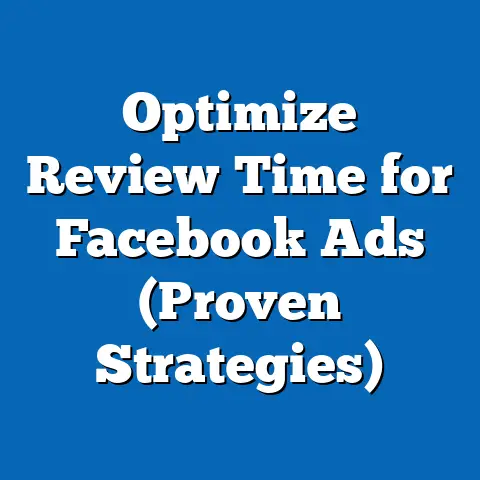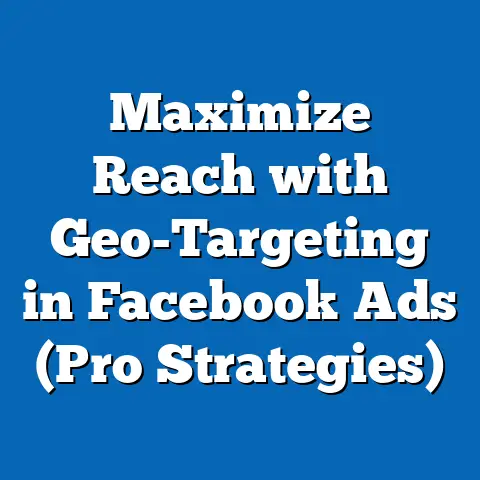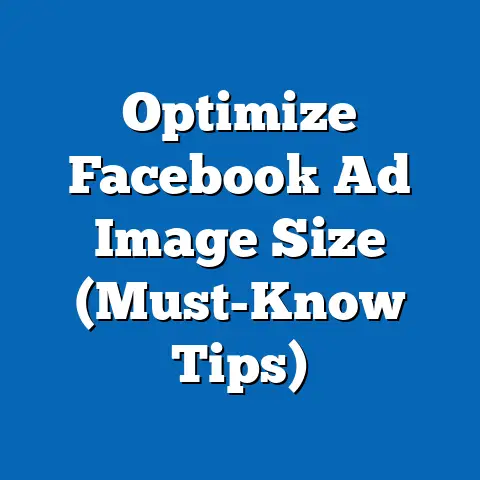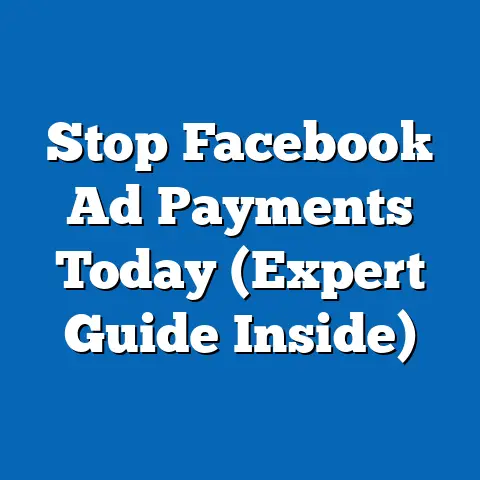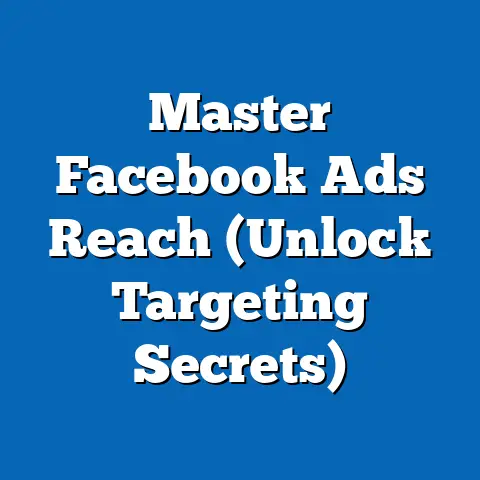Boost Facebook Ads Income (Proven Strategies Inside)
Boost Facebook Ads Income: Proven Strategies Inside
Imagine this: You’re an online business owner, sitting comfortably at your desk, eyes glued to your Facebook Ads dashboard. Numbers are dancing across the screen – clicks, conversions, and, most importantly, revenue. With each notification, you see your dreams of financial independence inching closer to reality. As you sip your morning coffee, you reflect on the strategic decisions that have transformed your ad spend into a powerful, income-generating machine. This isn’t just a pipe dream; it’s the reality for countless entrepreneurs who’ve mastered the art of Facebook Advertising.
Facebook, now under the Meta umbrella, has become an undeniable force in the marketing world. Its massive user base, sophisticated targeting options, and diverse ad formats create a fertile ground for businesses of all sizes to connect with their ideal customers and drive substantial revenue. But simply throwing money at Facebook Ads isn’t enough. It requires a deep understanding of the platform, a strategic approach, and a willingness to constantly test and optimize.
In this guide, I’m going to pull back the curtain and reveal the proven strategies that can help you transform your Facebook Ads from a cost center into a profit powerhouse. I’ll share my experiences, insights, and actionable tips that you can implement immediately to maximize your ROI and boost your Facebook Ads income. Let’s get started!
Understanding the Facebook Ads Ecosystem
Before we jump into the strategies, let’s lay the groundwork by understanding the fundamental components of the Facebook Ads ecosystem. I remember when I first started with Facebook Ads, it felt like navigating a maze. But once I grasped the basics, everything became much clearer.
Facebook Ads, at its core, is a platform that allows you to display advertisements to users based on their demographics, interests, behaviors, and more. The beauty of it lies in its precision – you’re not just shouting into the void; you’re targeting specific individuals who are most likely to be interested in your products or services.
Here’s a breakdown of some key elements:
-
Ad Formats: Facebook offers a variety of ad formats, each designed to capture attention in different ways.
- Image Ads: Simple yet effective, these ads use a single compelling image to convey your message.
- Video Ads: Perfect for storytelling and demonstrating your product in action.
- Carousel Ads: Allow users to scroll through multiple images or videos, showcasing different aspects of your offering.
- Collection Ads: Designed for e-commerce, these ads feature a catalog of products that users can browse directly within Facebook.
- Instant Experience Ads (formerly Canvas Ads): Full-screen, mobile-optimized ads that provide an immersive and engaging experience.
-
Ad Placements: Where your ad appears is just as important as what it says. Facebook offers various placement options:
- Facebook News Feed: The most common placement, appearing directly in users’ feeds alongside posts from friends and family.
- Facebook Stories: Short, engaging videos or images that disappear after 24 hours.
- Facebook Marketplace: Reaches users who are actively looking to buy or sell items.
- Instagram Feed: Extends your reach to Instagram’s vast user base.
- Instagram Stories: Similar to Facebook Stories, but on Instagram.
- Audience Network: Extends your reach to websites and apps outside of Facebook.
-
Targeting: This is where Facebook Ads truly shines. You can target users based on:
- Demographics: Age, gender, location, education, and more.
- Interests: Hobbies, passions, and topics they’ve shown interest in.
- Behaviors: Past purchases, online activity, and device usage.
- Custom Audiences: Reach users who have already interacted with your business (website visitors, email subscribers, etc.).
- Lookalike Audiences: Find new users who are similar to your existing customers.
-
The Algorithm: Facebook’s algorithm is the invisible hand that determines which ads users see and how much they cost. It constantly analyzes user behavior and ad performance to optimize the overall experience. Understanding how the algorithm works is crucial for maximizing your ad visibility and minimizing your costs.
Ad Formats: Facebook offers a variety of ad formats, each designed to capture attention in different ways.
- Image Ads: Simple yet effective, these ads use a single compelling image to convey your message.
- Video Ads: Perfect for storytelling and demonstrating your product in action.
- Carousel Ads: Allow users to scroll through multiple images or videos, showcasing different aspects of your offering.
- Collection Ads: Designed for e-commerce, these ads feature a catalog of products that users can browse directly within Facebook.
- Instant Experience Ads (formerly Canvas Ads): Full-screen, mobile-optimized ads that provide an immersive and engaging experience.
Ad Placements: Where your ad appears is just as important as what it says. Facebook offers various placement options:
- Facebook News Feed: The most common placement, appearing directly in users’ feeds alongside posts from friends and family.
- Facebook Stories: Short, engaging videos or images that disappear after 24 hours.
- Facebook Marketplace: Reaches users who are actively looking to buy or sell items.
- Instagram Feed: Extends your reach to Instagram’s vast user base.
- Instagram Stories: Similar to Facebook Stories, but on Instagram.
- Audience Network: Extends your reach to websites and apps outside of Facebook.
Targeting: This is where Facebook Ads truly shines. You can target users based on:
- Demographics: Age, gender, location, education, and more.
- Interests: Hobbies, passions, and topics they’ve shown interest in.
- Behaviors: Past purchases, online activity, and device usage.
- Custom Audiences: Reach users who have already interacted with your business (website visitors, email subscribers, etc.).
- Lookalike Audiences: Find new users who are similar to your existing customers.
The Algorithm: Facebook’s algorithm is the invisible hand that determines which ads users see and how much they cost. It constantly analyzes user behavior and ad performance to optimize the overall experience. Understanding how the algorithm works is crucial for maximizing your ad visibility and minimizing your costs.
Takeaway: Familiarize yourself with the different ad formats, placements, and targeting options available on Facebook. Understanding these fundamentals is the first step towards creating successful and profitable ad campaigns.
Crafting Compelling Ad Creative
Now that we understand the basics, let’s talk about the heart of your ad: the creative. No matter how well you target your audience, if your ad is boring or irrelevant, it’s going to fall flat. I’ve seen firsthand how a well-crafted ad can make all the difference between a successful campaign and a complete flop.
Creating compelling ad creative involves several key elements:
-
Visuals: Your image or video is the first thing users will see, so it needs to be eye-catching and relevant.
- High-Quality Images: Use professional-looking images that are well-lit and visually appealing.
- Engaging Videos: Create short, attention-grabbing videos that tell a story or demonstrate your product in action.
- Relevance: Ensure your visuals are directly related to your product or service and resonate with your target audience.
-
Messaging: Your ad copy should be concise, clear, and persuasive.
- Headline: The headline is the first line of text users will read, so make it count. Use strong verbs and focus on the benefits of your product or service.
- Body Text: Expand on your headline and provide more detail about your offering. Highlight the key features and benefits that will appeal to your target audience.
- Call to Action (CTA): Tell users what you want them to do next. Use clear and concise CTAs like “Shop Now,” “Learn More,” or “Sign Up.”
-
A/B Testing: Don’t just guess what works – test it! A/B testing involves creating multiple versions of your ad with different visuals, headlines, or CTAs, and then tracking which version performs best.
- Test One Element at a Time: To get accurate results, only change one element at a time. For example, test different headlines while keeping the visuals and body text the same.
- Use Facebook’s A/B Testing Tool: Facebook provides a built-in A/B testing tool that makes it easy to create and track your tests.
- Analyze the Results: Once your test is complete, analyze the results to identify the winning variation and use it in your future campaigns.
-
Brand Voice: Let your brand’s personality shine through in your ads.
- Be Authentic: Don’t try to be someone you’re not. Let your unique voice and values resonate with your target audience.
- Consistency: Maintain a consistent brand voice across all of your ads and marketing materials.
- Know Your Audience: Tailor your messaging to appeal to your target audience’s interests and preferences.
Visuals: Your image or video is the first thing users will see, so it needs to be eye-catching and relevant.
- High-Quality Images: Use professional-looking images that are well-lit and visually appealing.
- Engaging Videos: Create short, attention-grabbing videos that tell a story or demonstrate your product in action.
- Relevance: Ensure your visuals are directly related to your product or service and resonate with your target audience.
Messaging: Your ad copy should be concise, clear, and persuasive.
- Headline: The headline is the first line of text users will read, so make it count. Use strong verbs and focus on the benefits of your product or service.
- Body Text: Expand on your headline and provide more detail about your offering. Highlight the key features and benefits that will appeal to your target audience.
- Call to Action (CTA): Tell users what you want them to do next. Use clear and concise CTAs like “Shop Now,” “Learn More,” or “Sign Up.”
A/B Testing: Don’t just guess what works – test it! A/B testing involves creating multiple versions of your ad with different visuals, headlines, or CTAs, and then tracking which version performs best.
- Test One Element at a Time: To get accurate results, only change one element at a time. For example, test different headlines while keeping the visuals and body text the same.
- Use Facebook’s A/B Testing Tool: Facebook provides a built-in A/B testing tool that makes it easy to create and track your tests.
- Analyze the Results: Once your test is complete, analyze the results to identify the winning variation and use it in your future campaigns.
Brand Voice: Let your brand’s personality shine through in your ads.
- Be Authentic: Don’t try to be someone you’re not. Let your unique voice and values resonate with your target audience.
- Consistency: Maintain a consistent brand voice across all of your ads and marketing materials.
- Know Your Audience: Tailor your messaging to appeal to your target audience’s interests and preferences.
Example: I once worked with a local bakery that was struggling to get traction with their Facebook Ads. Their initial ads featured generic images of pastries and bland copy. We decided to revamp their creative by using high-quality photos of their most popular items, writing compelling headlines that highlighted the deliciousness and freshness of their baked goods, and adding a clear “Order Now” CTA. We also A/B tested different images and headlines to see what resonated best with their target audience. The result? A significant increase in click-through rates and online orders.
Takeaway: Invest time and effort in creating compelling ad creative that captures attention, communicates your message effectively, and aligns with your brand voice. A/B testing is your best friend – use it to continually optimize your ads and improve your performance.
Targeting the Right Audience
You can have the most beautiful ad in the world, but if it’s shown to the wrong people, it’s going to be a waste of money. Targeting is the key to reaching the right audience with your ads and maximizing your ROI. I’ve learned that the more specific you can get with your targeting, the better your results will be.
Facebook offers a wealth of targeting options, allowing you to reach users based on a variety of factors:
- Demographics: Target users based on their age, gender, location, education, job title, and more.
- Interests: Reach users who have shown interest in specific topics, hobbies, or activities.
- Behaviors: Target users based on their past purchases, online activity, device usage, and other behaviors.
- Custom Audiences: This is where things get really interesting. Custom Audiences allow you to upload your own customer data (email lists, phone numbers, etc.) to create targeted audiences on Facebook.
- Website Visitors: Retarget users who have visited your website but haven’t made a purchase.
- Email Subscribers: Reach your email subscribers with targeted ads on Facebook.
- Customer List: Target your existing customers with special offers or promotions.
- Lookalike Audiences: Take your Custom Audiences to the next level by creating Lookalike Audiences. Facebook will analyze your Custom Audience and find new users who share similar characteristics and interests.
- Website Visitors: Retarget users who have visited your website but haven’t made a purchase.
- Email Subscribers: Reach your email subscribers with targeted ads on Facebook.
- Customer List: Target your existing customers with special offers or promotions.
Here are some tips for effective targeting:
- Create Buyer Personas: Before you start creating your ads, take the time to develop detailed buyer personas. These are fictional representations of your ideal customers, based on research and data about your existing customers.
- Demographics: What is their age, gender, location, and income?
- Interests: What are their hobbies, passions, and interests?
- Pain Points: What problems are they trying to solve?
- Goals: What are they trying to achieve?
- Use Layered Targeting: Don’t rely on just one targeting option. Layer multiple targeting options together to create a more specific and relevant audience. For example, you could target women aged 25-35 who are interested in fitness and have recently purchased workout clothes online.
- Retargeting: Don’t let website visitors slip through the cracks. Retargeting is a powerful strategy for re-engaging users who have already shown interest in your business.
- Test Different Audiences: Just like with ad creative, it’s important to test different audiences to see what works best. Create multiple ad sets with different targeting options and track their performance.
- Demographics: What is their age, gender, location, and income?
- Interests: What are their hobbies, passions, and interests?
- Pain Points: What problems are they trying to solve?
- Goals: What are they trying to achieve?
Example: I helped a local bookstore increase their online sales by implementing a targeted retargeting campaign. We created a Custom Audience of website visitors who had viewed specific book pages but hadn’t added anything to their cart. We then created ads featuring those specific books and offered a special discount code. This campaign resulted in a significant increase in online sales and a higher ROI than their general awareness campaigns.
Takeaway: Targeting is the foundation of successful Facebook Ads. Take the time to understand your audience, create detailed buyer personas, and experiment with different targeting options. Retargeting and Lookalike Audiences are powerful tools that can help you reach new customers and maximize your ROI.
Optimizing Ad Performance
Creating great ads and targeting the right audience is only half the battle. You also need to constantly monitor and optimize your ad performance to ensure you’re getting the best possible results. I’ve learned that even the most successful campaigns can become stale over time, so it’s important to stay vigilant and make adjustments as needed.
Here are some key metrics to track:
- Click-Through Rate (CTR): The percentage of users who click on your ad after seeing it. A high CTR indicates that your ad is relevant and engaging.
- Conversion Rate: The percentage of users who complete a desired action (e.g., make a purchase, sign up for a newsletter) after clicking on your ad. A high conversion rate indicates that your landing page is effective and your offer is compelling.
- Cost Per Click (CPC): The amount you pay each time someone clicks on your ad. A low CPC indicates that your ad is efficient and your targeting is effective.
- Cost Per Acquisition (CPA): The amount you pay to acquire a new customer. A low CPA indicates that your overall campaign is profitable.
- Return on Ad Spend (ROAS): The amount of revenue you generate for every dollar you spend on advertising. A high ROAS indicates that your campaign is generating a significant return on investment.
Here are some tips for optimizing your ad performance:
- Use Facebook’s Ads Manager: Facebook’s Ads Manager provides a wealth of data and tools that you can use to track your ad performance and make adjustments.
- Set Clear Goals: Before you start your campaign, define your goals and KPIs. What do you want to achieve? How will you measure success?
- Monitor Your Performance Regularly: Don’t just set it and forget it. Check your ad performance regularly (at least once a day) to identify any issues and make adjustments as needed.
- Adjust Your Bidding Strategy: Facebook offers several bidding strategies, including automatic bidding and manual bidding. Experiment with different bidding strategies to see what works best for your campaign.
- Allocate Your Budget Wisely: Don’t spread your budget too thin. Focus your budget on the ad sets that are performing best.
- Address Ad Fatigue: If your ad performance starts to decline, it could be a sign of ad fatigue. This means that your audience is getting tired of seeing the same ad over and over again. To combat ad fatigue, try refreshing your creative, targeting a new audience, or pausing your ad for a few days.
- Scale Successful Campaigns: Once you’ve identified a campaign that’s performing well, scale it up by increasing your budget or expanding your targeting.
Example: I worked with an e-commerce client who was struggling to achieve a positive ROAS with their Facebook Ads. After analyzing their data, I discovered that their ads were generating a high CTR but a low conversion rate. This indicated that their landing page was not effective. We redesigned their landing page to be more user-friendly, mobile-optimized, and focused on the benefits of their products. As a result, their conversion rate increased significantly, and they were able to achieve a positive ROAS.
Takeaway: Optimization is an ongoing process. Continuously monitor your ad performance, analyze your data, and make adjustments as needed. Don’t be afraid to experiment with different bidding strategies, targeting options, and creative elements. Scaling successful campaigns and addressing ad fatigue are crucial for long-term success.
Leveraging Facebook Pixel and Analytics
The Facebook Pixel and Analytics are two powerful tools that can provide valuable insights into your ad performance and user behavior. I consider them essential for any serious Facebook advertiser.
-
Facebook Pixel: The Facebook Pixel is a small snippet of code that you place on your website. It tracks user behavior after they click on your ad, allowing you to:
- Track Conversions: See which ads are driving the most conversions.
- Retarget Website Visitors: Reach users who have visited your website but haven’t made a purchase.
- Optimize Campaigns: Improve your ad targeting and bidding strategies based on real-world data.
- Create Lookalike Audiences: Find new users who are similar to your existing customers.
-
Facebook Analytics: Facebook Analytics provides a comprehensive overview of your audience, their behavior, and the effectiveness of your marketing efforts. It allows you to:
- Understand User Demographics: Learn more about your audience’s age, gender, location, and interests.
- Track User Engagement: See how users are interacting with your website or app.
- Analyze Conversion Paths: Understand the steps users take before converting.
- Identify Trends and Opportunities: Discover new ways to improve your marketing strategies.
Facebook Pixel: The Facebook Pixel is a small snippet of code that you place on your website. It tracks user behavior after they click on your ad, allowing you to:
- Track Conversions: See which ads are driving the most conversions.
- Retarget Website Visitors: Reach users who have visited your website but haven’t made a purchase.
- Optimize Campaigns: Improve your ad targeting and bidding strategies based on real-world data.
- Create Lookalike Audiences: Find new users who are similar to your existing customers.
Facebook Analytics: Facebook Analytics provides a comprehensive overview of your audience, their behavior, and the effectiveness of your marketing efforts. It allows you to:
- Understand User Demographics: Learn more about your audience’s age, gender, location, and interests.
- Track User Engagement: See how users are interacting with your website or app.
- Analyze Conversion Paths: Understand the steps users take before converting.
- Identify Trends and Opportunities: Discover new ways to improve your marketing strategies.
Here are some tips for leveraging Facebook Pixel and Analytics:
- Install the Pixel on Your Website: This is the first and most important step. Make sure the Pixel is installed correctly on every page of your website.
- Set Up Conversion Tracking: Define the key actions you want to track (e.g., purchases, sign-ups, form submissions) and set up conversion tracking in Facebook Ads Manager.
- Analyze Your Data Regularly: Don’t just collect data – analyze it! Use Facebook Analytics to understand your audience, their behavior, and the effectiveness of your marketing efforts.
- Use Pixel Data to Optimize Your Campaigns: Use the data you collect from the Pixel to improve your ad targeting, bidding strategies, and creative elements.
- Create Retargeting Audiences: Use Pixel data to create retargeting audiences of website visitors who haven’t converted.
- Create Lookalike Audiences: Use Pixel data to create Lookalike Audiences of users who are similar to your existing customers.
Example: I helped a local restaurant improve their online ordering system by leveraging Facebook Pixel and Analytics. We installed the Pixel on their website and set up conversion tracking to track online orders. After analyzing the data, we discovered that many users were abandoning their carts before completing their orders. We then used retargeting ads to remind these users about their abandoned carts and offer them a small discount. This campaign resulted in a significant increase in online orders and a higher ROI than their previous campaigns.
Takeaway: The Facebook Pixel and Analytics are invaluable tools for any Facebook advertiser. Use them to track user behavior, optimize your campaigns, and gain valuable insights into your audience.
Conclusion
Boosting your Facebook Ads income requires a combination of creativity, strategy, and data analysis. By understanding the Facebook Ads ecosystem, crafting compelling ad creative, targeting the right audience, optimizing your ad performance, and leveraging the Facebook Pixel and Analytics, you can transform your Facebook Ads from a cost center into a profit powerhouse.
Remember, consistent testing and refinement are key to success. Don’t be afraid to experiment with different strategies and track your results. The more you learn and adapt, the better your results will be.
I encourage you to implement these proven strategies and monitor your results. With dedication and perseverance, you can unlock the full potential of Facebook Ads and achieve your business goals. Now, go out there and transform your Facebook Ads campaigns into a significant source of revenue!

